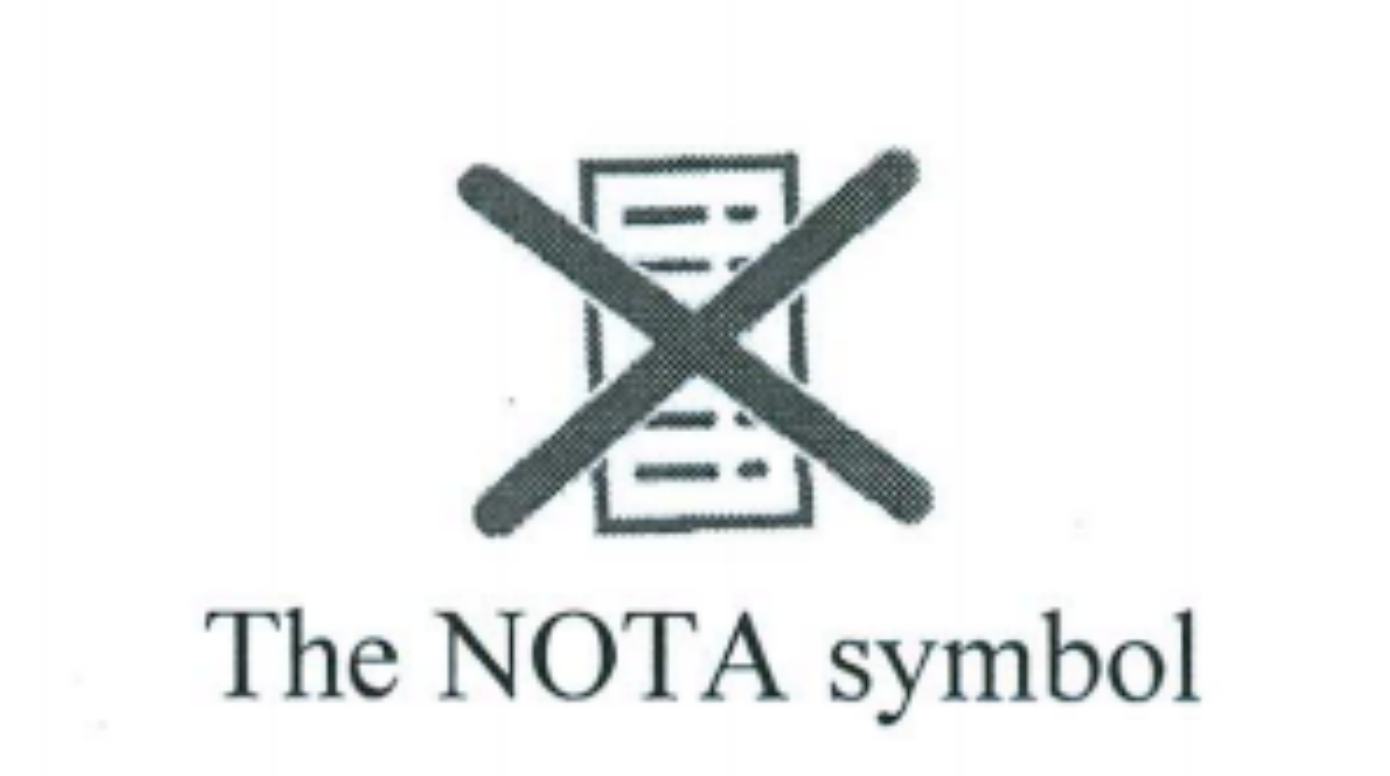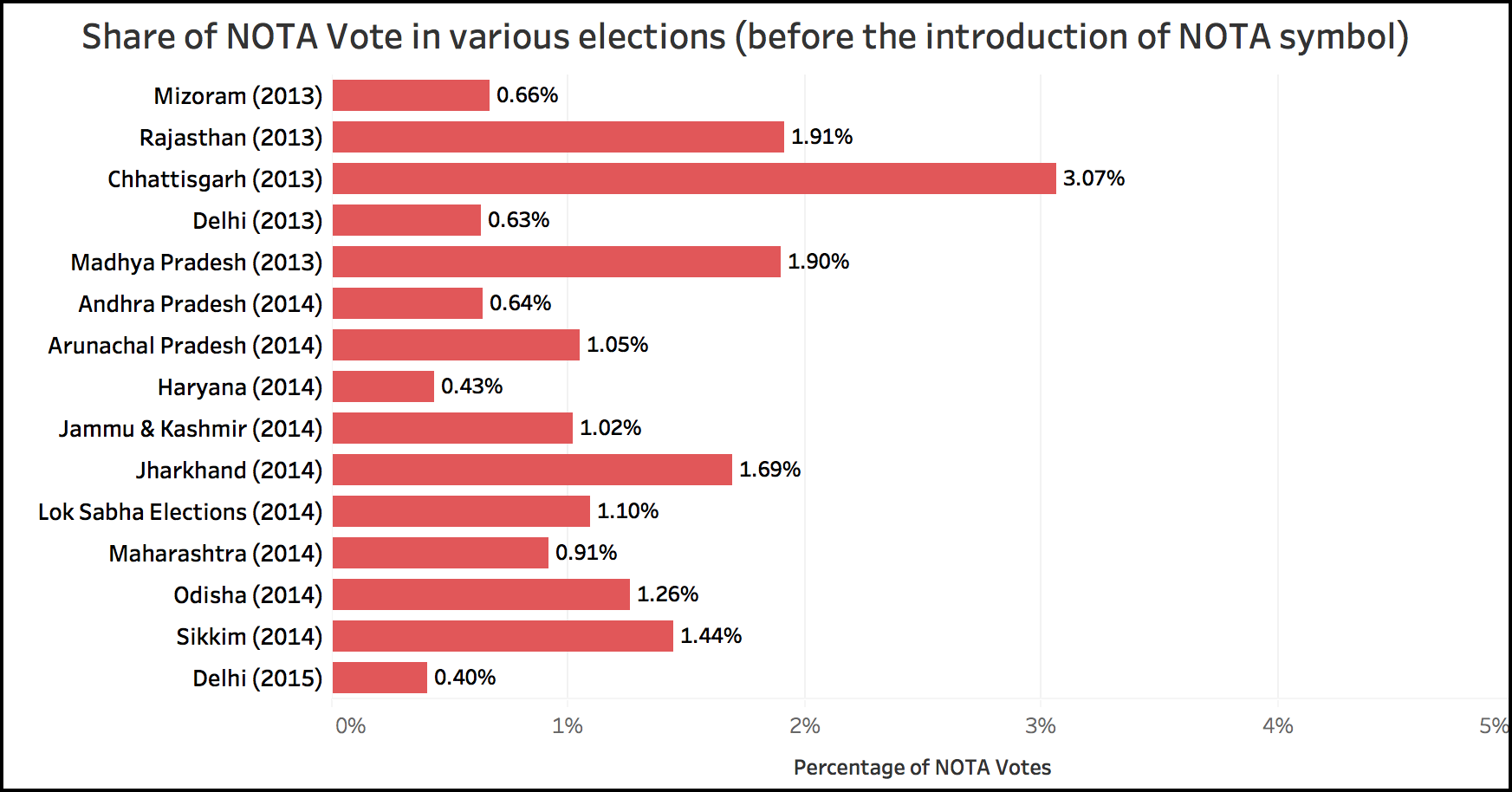[orc]None of the Above (NOTA) was first introduced on the EVMs following a Supreme Court Judgment in 2013. Since 2013, NOTA was used in elections to 31 assemblies and the 2014 Lok Sabha election. Has the NOTA vote share increased since 2013? Has the introduction of a symbol in 2015 made any difference?
None of the Above (NOTA) was introduced as the last entry on the EVM after the names of all contesting candidates, following a Supreme Court (SC) judgment in 2013. Since then, NOTA vote share is only 1.18% of the total votes polled in 32 elections.
What is NOTA?
The basis for NOTA is rule 49-O in the ‘Conduct of Elections Rules, 1961‘. If a voter decides not to vote for any of the contesting candidates, his/her name will be duly entered in the register of voters in Form-17A along with the voter’s signature. An entry to the effect ‘refused to vote’ is also made in the list. It has to be understood that the total count of 49-O has no impact on the eventual results. Even if the total number of voters who opted for 49-O exceeds the maximum votes polled for any candidate, it does not make any difference. The candidate who receives the maximum vote is still declared as the winner. This rule is only to express dissatisfaction with the contesting candidates.
This rule was challenged in the Supreme Court (SC) saying it violates the secrecy of voting since the presiding officer knows who opted for this rule. The SC, in its judgment in the year 2013, declared that this rule indeed violates the secrecy of voting and directed the Election Commission (ECI) to provide a NOTA option on the EVM.
Following the SC judgment, the ECI introduced the NOTA option on EVMs starting October 2013. The rules applicable for 49-O would also be applicable in the case of NOTA as far impact on results are concerned. Thus, NOTA is only a way to express rejection/dissatisfaction with the existing candidates and does not in anyway impact the result. In September 2015, the ECI also announced a dedicated symbol for NOTA on the EVM.

No substantial increase in the NOTA vote share
Elections were held to Assemblies of 31 states and the Lok Sabha since the introduction of NOTA in 2013. Out of the 32 elections, 15 were held before the ECI introduced the dedicated NOTA symbol and 17 were held after the introduction of the NOTA symbol in 2015. In the 15 elections held between 2013 & 2015 (when NOTA was available on the EVM without a symbol), NOTA vote share ranged from 0.4% in Delhi (2015) to a highest of 3.07% in Chhattisgarh (2013). The average NOTA vote share in these 15 elections was about 1.15%.
 The NOTA symbol was first used in the Bihar elections of 2015. Out of the 17 elections held since then, NOTA vote share was more than 1% in 9 of the elections and less than 1% in the remaining 8 elections. The highest vote share of 2.48% for NOTA was registered in the Bihar elections of 2015. The average vote share after NOTA symbol was introduced is 1.27%.
The NOTA symbol was first used in the Bihar elections of 2015. Out of the 17 elections held since then, NOTA vote share was more than 1% in 9 of the elections and less than 1% in the remaining 8 elections. The highest vote share of 2.48% for NOTA was registered in the Bihar elections of 2015. The average vote share after NOTA symbol was introduced is 1.27%.
 Continuous decrease in NOTA Vote share
Continuous decrease in NOTA Vote share
The NOTA vote share has been continuously decreasing each year. Before the symbol was introduced in 2015, the vote share for NOTA decreased from 1.96% in 2013 to 0.4% in 2015. After the symbol was introduced in 2015, the NOTA vote share decreased from 2.48% in 2015 to 0.89% in 2018. The data clearly shows that awareness about NOTA is not widespread and hasn’t resulted in voters choosing NOTA.

Read Part 2 here


